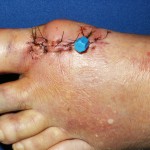One of the most frequent questions I am used to be asked is about when antibiotic prophylaxis should be used in performing foot and ankle surgery. I have an entire lecture on this topic where I go through the data, or lack thereof, on the subject and suggest the clinical situations where prophy has traditionally been utilized (i.e. surgery longer than 2 hours, trauma surgery, immunocompromised hosts, etc). More and more the question posed to me has become: “Warren, my hospital requires me to use prophylactic antibiotics even when I don’t feel they are necessary. They have actually threatened to take away my surgical privileges if I don’t use them. What can I do about that?” Unfortunately, the answer is…not much.
Why is this happening? What has changed? In my opinion there are two main reasons we have come to be in this situation. 1) The Surgical Care Improvement Project (SCIP) 2) Changes in CMS guidelines that will not reimburse a hospital for a re-admission for a nosocomial infection.
Point #2 is fairly self explanatory. Hospitals don’t get paid if a patient is readmitted with a diagnosis of a nosocomial post operative infection. Therefore, they need to try everything in their power to prove that any infection that does occur is not their fault and they did everything possible to prevent that infection. Chief amongst these is demanding prophylactic antibiotics be given to everyone undergoing surgery. Then, when the patient gets infected they can always claim that the infection was community acquired and not nosocomial.
Point #1, SCIP, may not be as well known by the average lower extremity surgeon and is a bit more complicated. Back in 2005 a national initiative was developed to attempt to reduce post operative complication rates by 25% in a 5 year period. A set if 20 measures were developed, 9 are publicly reportable, 6 of which focused specifically on postoperative infection prevention. 4 of these are directly relatable to lower extremity work. These include:
1. INF-1: Patients need to receive prophylactic antibiotics within one hour prior to surgical incision or 2 hours if using vancomycin.
2. INF-2: Patients receive prophylactic antibiotics recommended for their specific surgical procedure
3. INF-3: Patients prophylactic antibiotics are discontinued within 24 hours after surgical end time
4. INF-6: Surgery patients should have appropriate hair removal with a clippers or depilatory, if at all (no razors)
I think that all readers would agree that this is a lofty and worthy goal. The program is “voluntary” although CMS reduces hospital reimbursement by 2% if they fail to report performance on the various measures. Probably, for this reason, the participation rate is around 95% of all hospitals. Now the bad news…IT MAY NOT BE WORKING!
In the June 23, 2010 issue of the Journal of the American Medical Association, Stulberg and colleagues published a retrospective cohort analysis of over 400,000 patient discharges between 2006 and 2008 (PubMed Link: http://www.ncbi.nlm.nih.gov/pubmed?term=Stulberg%20JJ%20AND%20SCIP ). They found that when the measures were taken all together in an “all or none” infection prevention score, there was a lower probability of developing a post operative infection. However, adherence to any individual measure (such as the use of prophylactic antibiotics) was NOT associated with a significantly lower probability of infection.
There are some other interesting tidbits to take away from this study. The category of “Neck, Back or Extremity Surgery” presented with the overall lowest rate of post operative infection at only 0.19%. Also, in fairness, although not reaching a level of statistical significance, the use of prophy did decrease the overall risk of infection from 21.0 to 7.5 per 1000 discharges (unfortunately, this was not broken out by procedure type). I would also point out that the SCIP protocols do not demand all patients receive antibiotics, just that the “recommended” antibiotic, according to nationally accepted guidelines, is given. Somehow this seems to have been morphed into a requirement to administer them.
So what does this all mean to the lower extremity surgeon? The risk of infection for our surgery remains very low, somewhere probably well below 1.0%. In the largest study of its type, published in JFAS in 2004, Zgonis retrospectively looked at charts from 555 patients undergoing elective foot and ankle surgery and found no statistically significant difference in infection rate in the group that received prophy vs. those who did not (PubMed link: http://www.ncbi.nlm.nih.gov/pubmed/15057856 ). The bottom line is that prophylactic antibiotic use is probably not medically necessary in these patients. Unfortunately, unless you are ready to really “battle City Hall”, from a practical standpoint you are going to continue to be coerced into using antibiotics you suspect are not beneficial.
I find this all rather ironic. In an environment where hospitals are being required (at the risk of the same possible decrease in reimbursement) to have Antimicrobial Stewardship programs to effectively decrease antibiotic usage, physicians are being told by those same administrations that they need to use antibiotics that are probably not necessary.


